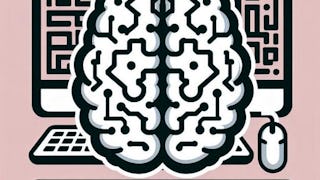The course "Advanced Methods in Machine Learning Applications" delves into sophisticated machine learning techniques, offering learners an in-depth understanding of ensemble learning, regression analysis, unsupervised learning, and reinforcement learning. The course emphasizes practical application, teaching students how to apply advanced techniques to solve complex problems and optimize model performance. Learners will explore methods like bagging, boosting, and stacking, as well as advanced regression approaches and clustering algorithms.


Advanced Methods in Machine Learning Applications
本课程是 Applied Machine Learning 专项课程 的一部分

位教师:Erhan Guven
包含在  中
中
您将学到什么
Understand and apply ensemble methods to improve model accuracy and robustness by combining multiple learning algorithms.
Explore advanced regression techniques for predicting continuous outcomes and modeling complex relationships in data.
Apply unsupervised learning algorithms for clustering, dimensionality reduction, and pattern recognition in unlabeled data.
Understand and implement reinforcement learning techniques and apriori analysis for decision-making and association rule mining.
您将获得的技能
要了解的详细信息

添加到您的领英档案
12 项作业
了解顶级公司的员工如何掌握热门技能

积累特定领域的专业知识
- 向行业专家学习新概念
- 获得对主题或工具的基础理解
- 通过实践项目培养工作相关技能
- 获得可共享的职业证书

该课程共有5个模块
This course provides a comprehensive exploration of advanced machine-learning techniques, including ensemble methods, regression analysis, and unsupervised learning algorithms. Students will gain hands-on experience with reinforcement learning and decision tree models while applying association rule mining on real datasets. Emphasis is placed on evaluating model performance and comparing various learning approaches. By the end, participants will be equipped with practical skills to tackle complex data-driven challenges.
涵盖的内容
2篇阅读材料
You can enhance supervised learning by using multiple weak classifiers that work on subsets of features with limited learning capability. By leveraging their sheer numbers and majority voting, ensemble classifiers consistently outperform and offer greater robustness than complex individual classifiers. Random Forest, considered one of the premier ensemble classifiers, relies on weak decision tree classifiers. Therefore, decision tree classifiers and their visualizations will be introduced in this module. Furthermore, you will see how employing numerous weak classifiers with reduced feature sets from the dataset can achieve combined voting performance that surpasses that of individual classifiers.
涵盖的内容
4个视频2篇阅读材料3个作业1个非评分实验室
Certain problems you encounter will demand precise numerical predictions, such as forecasting the seasonal flu arrival rate or predicting next week's stock market index. For such scenarios, regression techniques prove invaluable. Throughout this module, you'll explore various types of regression, solve linear regression equations analytically, define cost functions, and understand situations where linear regression may falter. Additionally, you'll delve into coding quadratic and logistic regressions from scratch, utilizing polynomial features and sci-fi optimizers. Logistic regression, a widely used classification method, fits data to a logistic curve based on dataset features. You'll apply logistic regression to develop a predictive model for cancer recurrence using patient diagnostic data.
涵盖的内容
4个视频3篇阅读材料3个作业1个非评分实验室
In this module, you will explore unsupervised learning, which serves as the counterpart to supervised learning. Unsupervised learning aims to construct the underlying probability distribution of a dataset based on its features as random variables, enabling it to identify outliers and centroids of densities. You'll begin by understanding distance and similarity metrics crucial for clustering algorithms. Popular algorithms like k-means, DBSCAN, hierarchical clustering, and EM will be introduced briefly. You'll also learn about metrics that evaluate cluster quality, alongside 3D visualizations and dendrograms. Using an artificial dataset similar to the one used in supervised learning, you will apply clustering techniques. Additionally, you'll witness clustering in action on the famous iris dataset, employing various algorithms. Throughout, you'll discover how the Elbow method aids in determining the optimal number of clusters.
涵盖的内容
4个视频2篇阅读材料3个作业1个非评分实验室
In this module, you will explore reinforcement learning, completing the trio of major learning strategies alongside supervised and unsupervised methods. Similar to how humans learn to navigate their environments, reinforcement learning operates in scenarios where ground truth is absent or impractical, relying instead on interactions with the environment. You'll discover how guidelines are learned through rewards and penalties to maximize benefits or minimize costs. Reinforcement learning is widely applied in teaching computers to play complex board games like Backgammon or chess—AlphaGo's triumph over the Go world champion exemplifies its capabilities in AI advancement. You'll delve into the reinforcement model, terminology, and typical problems such as tic-tac-toe and elevator control. Techniques for developing a mathematical model like Q-learning, based on states and actions, will be explored, culminating in hands-on implementation to master a chosen game.
涵盖的内容
6个视频3篇阅读材料3个作业1个编程作业
获得职业证书
将此证书添加到您的 LinkedIn 个人资料、简历或履历中。在社交媒体和绩效考核中分享。
位教师

从 Machine Learning 浏览更多内容
 状态:免费试用
状态:免费试用Fractal Analytics
 状态:免费试用
状态:免费试用Johns Hopkins University
 状态:免费试用
状态:免费试用Fractal Analytics
人们为什么选择 Coursera 来帮助自己实现职业发展




常见问题
To access the course materials, assignments and to earn a Certificate, you will need to purchase the Certificate experience when you enroll in a course. You can try a Free Trial instead, or apply for Financial Aid. The course may offer 'Full Course, No Certificate' instead. This option lets you see all course materials, submit required assessments, and get a final grade. This also means that you will not be able to purchase a Certificate experience.
When you enroll in the course, you get access to all of the courses in the Specialization, and you earn a certificate when you complete the work. Your electronic Certificate will be added to your Accomplishments page - from there, you can print your Certificate or add it to your LinkedIn profile.
Yes. In select learning programs, you can apply for financial aid or a scholarship if you can’t afford the enrollment fee. If fin aid or scholarship is available for your learning program selection, you’ll find a link to apply on the description page.
更多问题
提供助学金,




